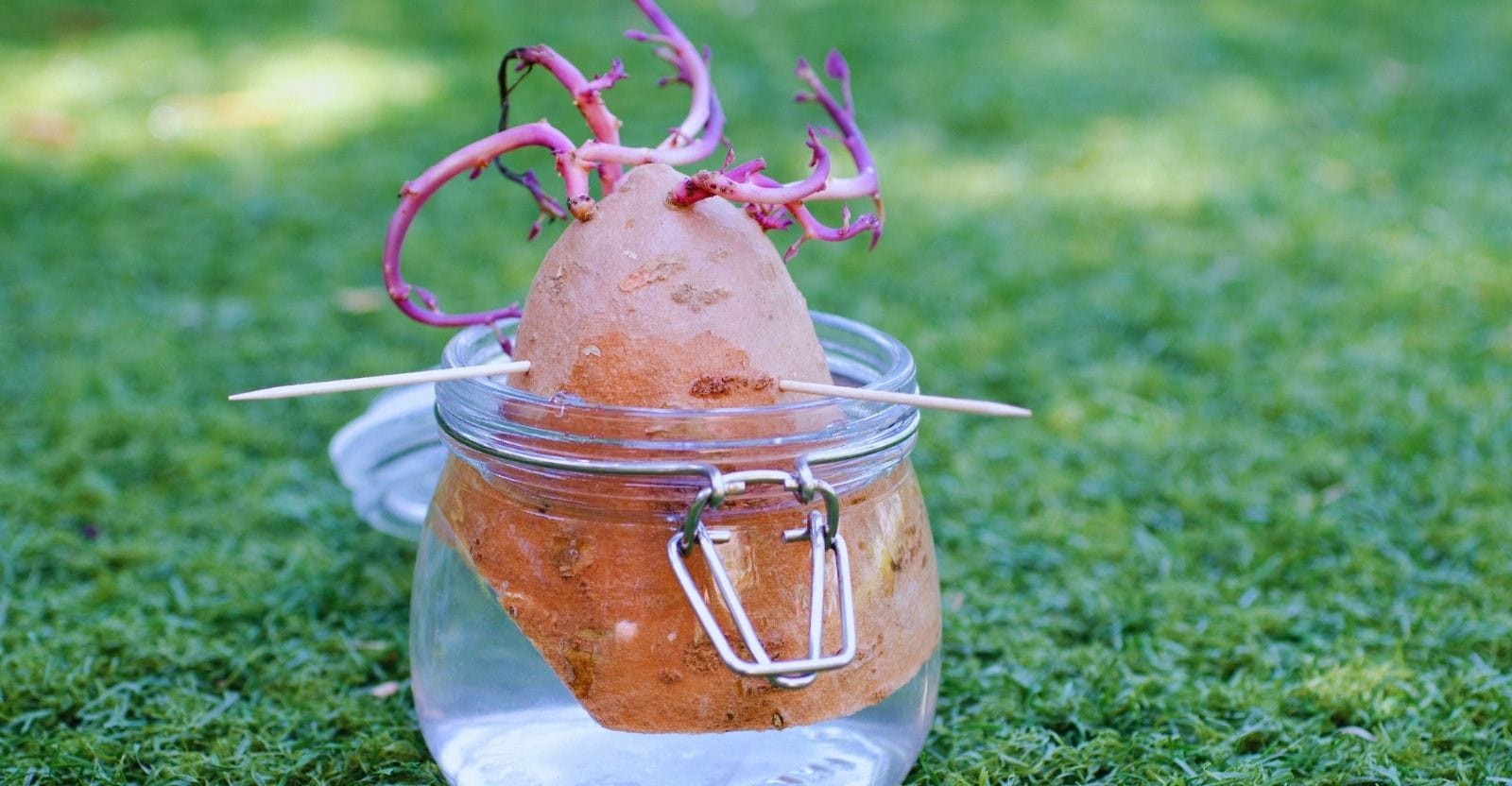Amazon has put together some great Home Gift Deals – save money and get your shopping done at the comfort of your home! Click here to see deals on Amazon
If you live in a warmer climate, you might be able to grow sweet potatoes right in your backyard. They’re easy to grow, and you can plant them on the ground or in containers.
Growing sweet potatoes is a fun activity that can be done whether you have a lot of space or not. You can plant them straight from the store-bought plant or from sweet potato slips.
Read on to learn how to grow low-fat, high fiber, and an excellent source of vitamin A sweet potatoes quickly in your home.
Why should you grow sweet potatoes?
Sweet potatoes (Ipomoea batatas) are popular vegetables in many parts of the world. But a few people are still a bit skeptical about growing their own. However, there is no better source of nutrition than Mother Nature’s garden.
When you’re ready to grow sweet potatoes, you can grow them from slips rather than seeds, buds, or sprouts. If you’re not aware, sweet potato slips are green vines that grow from the mother root when it sprouts. The grown-up slip vines are removed from the vegetable and planted to grow new plants.
There are two types of sweet potatoes—the gourmet variety and the standard variety. The gourmet type is usually grown as a tuber with its long, cylindrical plant. The standard variety is produced as a root crop, and it stores well.
You can harvest it many times during the growing season, providing enough sweet potatoes for several months. You can grow both types from a slip.
You should start growing slips 6–8 weeks after the risk of ground freezing has passed in the early spring. For the best results, you should plant it in a staggered approach. A single sweet potato can grow 15–25 slip vines that you can use for planting.
Note:
The difference between a regular potato (such as a white potato) and a sweet potato is that a regular potato is a tuber, while a sweet potato is a root.
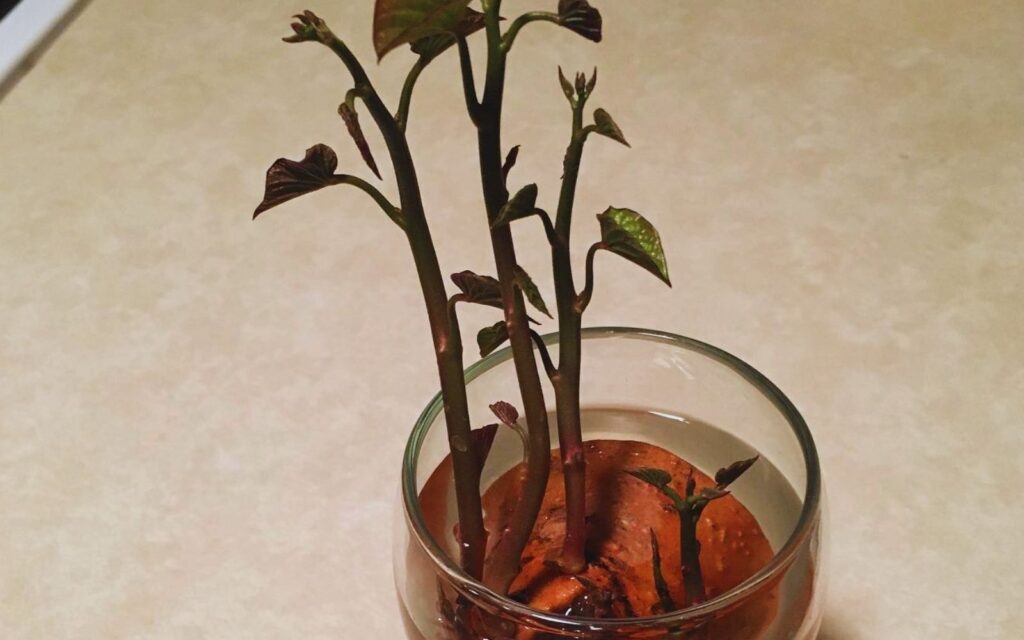
How to grow sweet potato from slips?
When it comes to growing sweet potatoes, you can buy a nursery plant from a garden center or grow your slips from any existing sweet potato root.
They grow well in suitable conditions, and commercial growers like to plant bare-root slips. If you live in a tropical zone, you can start growing slips from January to February to become ready to plant it in March—April. Make sure that the risk of frost has passed if you live in other zones.
There are two ways you can grow sweet potatoes:
- Grow slip in a jar of water
- Grow it in a soil
Follow these steps for growing sweet potato slips.
Step 1: Choose a healthy sweet potato. When buying it from a store, inspect for any cold damage or rotting on the roots. The cold damaged potatoes will have dark spots on them with discoloration around the damaged area.
Picking a healthy and fresh, small to medium-sized sweet potato (with no rat-tails) gives you the best chance of successfully growing slips.
There is no benefit of picking a bigger-sized sweet potato as each root will produce a maximum of 15–25 slips regardless of root size. Wash the root to prepare for its slip germination.
Step 2: After you have selected the fresh and healthy sweet potato, you can grow slips either of these methods:
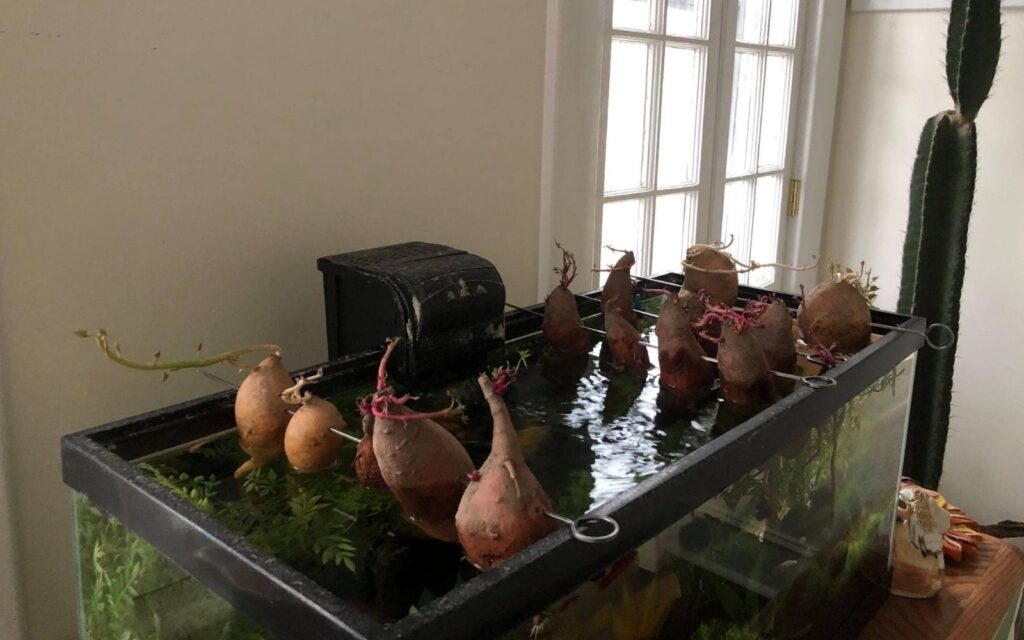
Method 1: Grow slips in the water
- First, identify the rooting end of the sweet potato as that has to go under the water. The rooting side will have a small thin root extending outward. The other side will be a bit thicker with more eyes on it.
- Fill up a jar with water, and the jar opening should be wide enough to fit sweet potato inside. For large potatoes, you can cut them in half or a large section. Insert a couple of toothpicks around the sweet potatoes to hold them in a jar.
- Place the sweet potato in a mason jar. Keep the mother root side underwater and the rest above water. You can adjust the toothpicks to hold it outside the water.
- It may take anywhere 6–8 weeks for the slips to germinate. You can expedite the process by placing the growing jar under a grow light or use a seeding warming mat.
- To keep the water fresh in the jar, replace it weekly or so. In a few weeks, roots will start to form on the potato then sprout. You have to separate these plantable slips once they’ve sprouted and have grown to be about 6 to 7 inches long.
- Remove sweet potato from the jar and carefully twist slips to separate it. You should inspect the slips and discard any weak or rotting sweet potato root slips.
Method 2: Growing slips in a soil method
- One of the downsides of growing slips in water is that it takes longer to grow slips. You can speed up the process by growing it in the loose soil, where it usually takes less than 4–6 weeks to grow slips.
- To get started, you have to prepare well-drained, sandy loam potting soil. If you’re planting it in an outdoor garden bed, spread a self-decomposing weed barrier fabric at the bottom. Adding plastic mulch prevents the weed from growing in the soil and helps maintain the warm soil temperature. This cuts down the sprouting time.
- If you’re growing slips indoor, you can spread the moist soil in a foil pan with holes in the bottom. Use a lid under the foil pan to catch excess water after irrigation. Insert potato in the soil with sprouting side above from the soil.
- Lightly water the soil to keep it moisturized. Place it where the temperature remains between 75°F—85°F (24°C—29°C) with humidity above 95%. This helps you grow more and healthier slips from the potato root. I prefer to use a grow light that helps speed up the process.
- In a week, you can feel the roots forming in the soil, holding the potato firmly in its place. In the next two weeks, tiny sprouts begin to grow from the sweet potato. After these sprouts have grown 6–7 inches long, remove them from the root as it’s ready to be planted.
Step 3: Prepare the ground where you want to plant the slips. Be careful to handle these slips gently as they’re prone to break quickly. When growing in a container, use a nutrient-rich organic composted potting mix.
If you’re not ready to plant slips right away, you can wrap the slip roots in a moistened paper towel or cloth rag. Store it away from sunlight and stand slips in an upright position. Soak the slip roots in water for about an hour each day, then place them at a dry location.
Step 4: Place the slips in the ground so that the bottom half is under the soil and the top portion remains outside for the leaves to grow. Remove any weeds or grass around the earth and gently press the dirt to get rid of the air pocket. Be careful not to compress the soil excessively.
Step 5: The sweet potato plant grows best when the soil temperature remains around 65°F (18°C). Protect your new plant from insects, moles, and mice who like to burrow under the soil and damage the roots. Keep the soil moist to grow healthy roots and lush green sweet potato leaves.
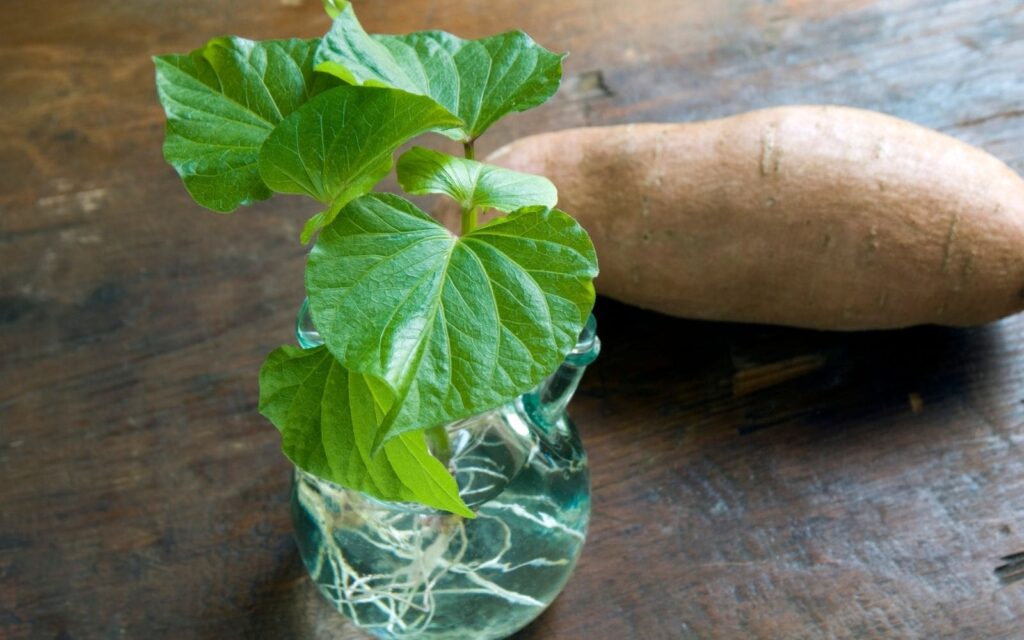
How far apart do you plant sweet potato slips?
You should plant sweet potato slips about 14–20 inches apart and 4 inches deep. You can prepare the soil by adding fertilizer with high phosphorous concentration as it helps with the rooting.
The sweet potato vine is a fast grower, and it quickly spreads to cover the wider area. They will continue to root into the soil at its nodes. Depending on the sweet potato variety, it can grow anywhere from 3 to 20 feet long. Providing adequate space gives the plant a better chance to develop fully.
Once the slips are placed in the soil, water them. You have to give them a deep soaking until the ground is wet. New growing plants need to be watered daily for the first week then every other day in the second week.
Keep an eye on the ground condition to increase the sweet potato yield. Maintain the soil to remain moist but not soggy. If you find the ground to be dry or wet, adjust the watering schedule. Make sure you water them during the hottest summer because if you don’t, they will produce less.
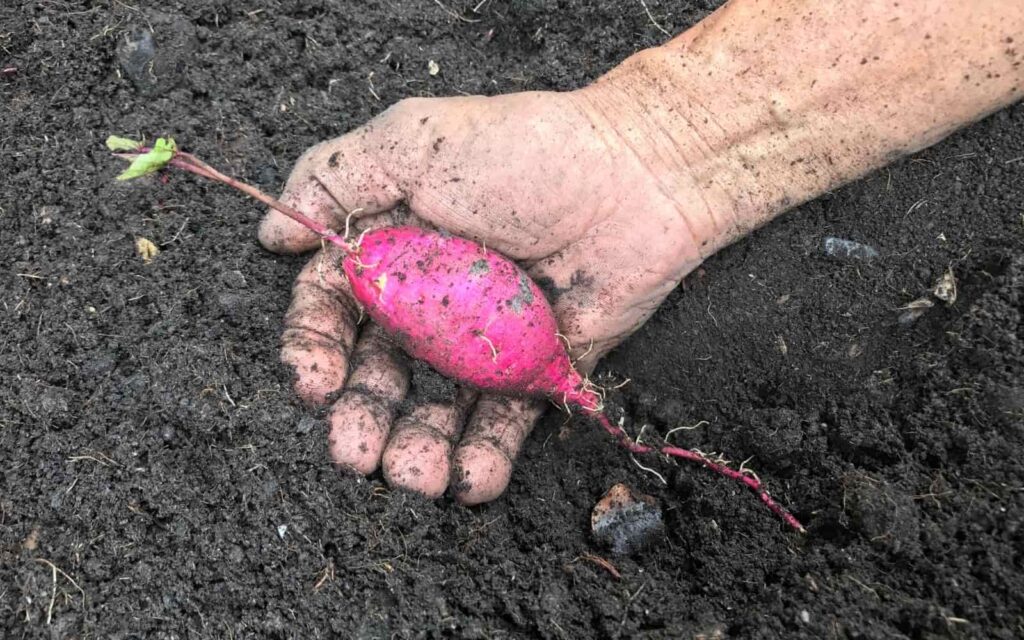
When to harvest sweet potato?
The time to harvest sweet potato (and sweet potato tuber) depends on the cultivar and the weather conditions in your area. Usually, for most varieties, it takes anywhere from three to four months for it to mature. Some newer types take less time to harvest and are bred for a short-season northern climate.
You should check the weather and harvest it during the nighttime. You shouldn’t let it remain in the ground when the temperature starts dipping below 40°F— 30°F (4°C to -1°C). It increases the risk of frost damage. But if the weather conditions are favorable, you can let it remain in the soil to grow it bigger and increase harvests.
After harvesting, make sure you cure them. This improves the flavor and allows you to store it longer. You can cure sweet potatoes by leaving pulled-out potatoes to dry naturally in the sun and exposed to fresh air. The suitable temperature to cure is at 85°F–90°F (30°C–32°C).
You can store them in a wooden box or burlap sack and move them at cooler temperatures between 55°F–60°F (13°C–15°C). Ensure that there is sufficient 75%–80% humidity at the storage location. You should regularly check the potato condition and remove any green or rotting potato. This prevents the spread of infection to other healthy potatoes.
An adequately cured sweet potato lasts longer and provides a regular supply of healthy and nutritious vegetables for several months.
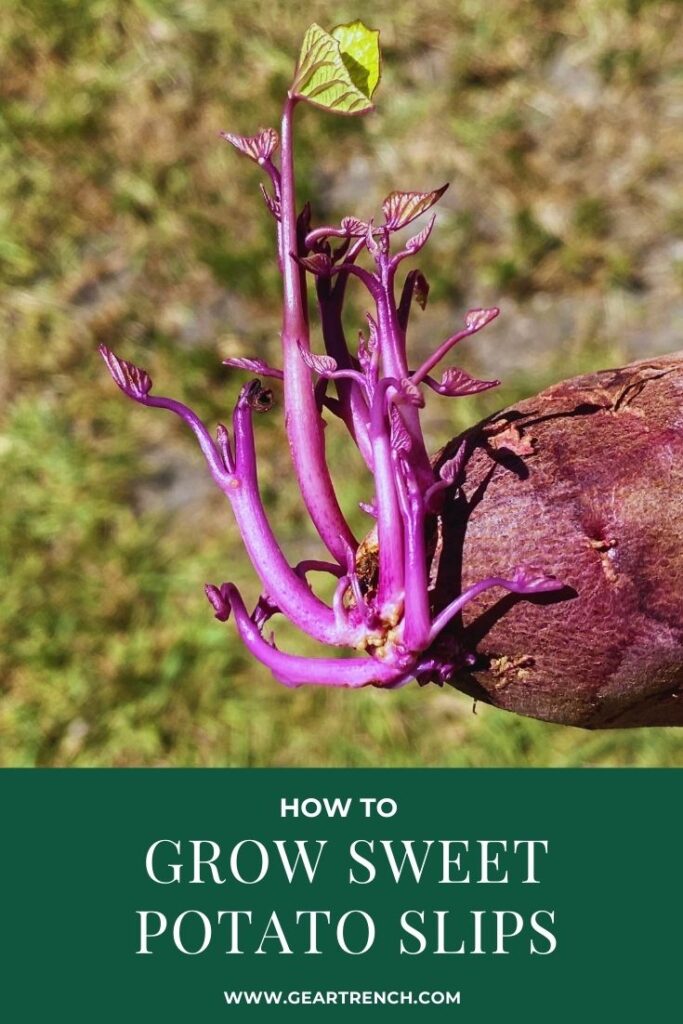
Don’t forget to share this post

